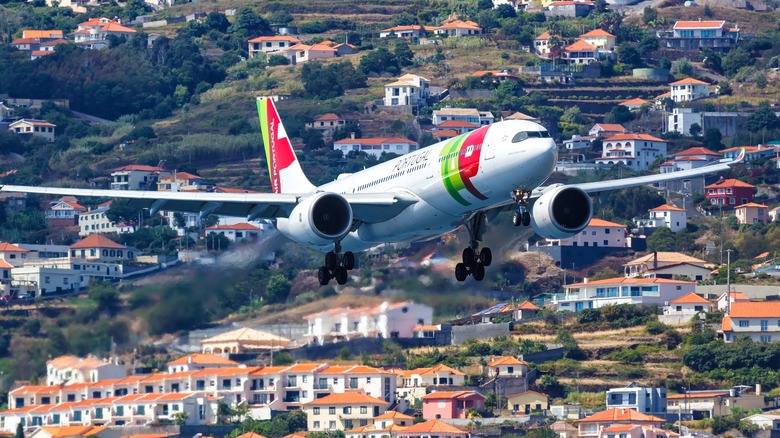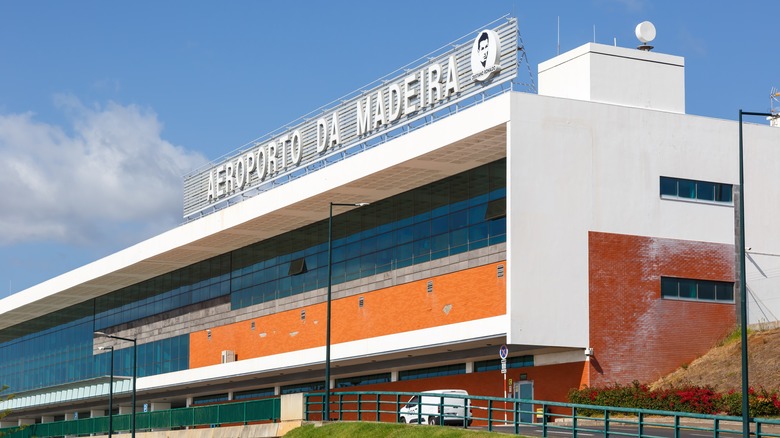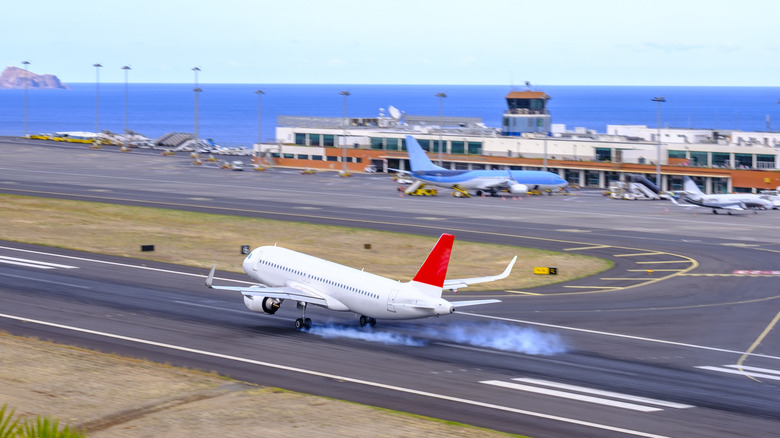The Unsettling Reason Flights To Madeira Often Take Much Longer Than Expected
Madeira, Portugal is a destination in the Atlantic Ocean that offers a stunning landscape for the adventure of a lifetime. With its turquoise waters and vivid greenery, the beaches are astoundingly beautiful. Sites like the Monte Palace Madeira, a breathtaking botanical garden, and the natural swimming pools of Porto Moniz will transport you to another world. Even better? This gorgeous island won't break the bank. If you're sold on this Portuguese paradise, you'll have to fly into Madeira Airport (FNC). However, this is no easy feat and can take multiple attempts.
Located near Funchal, Madeira's capital, FNC is notorious for its perilous winds. Note that Madeira's weather and winds are influenced by its position in the North Atlantic Ocean. According to AeroTime, the wind speed at FNC averages 22.76 knots, roughly over 26 miles per hour. Likewise, the winds have been known to reach over 45 miles per hour.
Needless to say, this does not make for optimal flying conditions. As might be expected, this can hinder pilots from landing the plane. Videos on social media show planes struggling to land at FNC against the high-speed winds. In fact, Madeira has a mandatory 15-knot wind limit (over 17 miles per hour), which can also thwart planes from landing.
What happens when a plane can't land in Madeira?
If the weather is too severe and the plane cannot land at Madeira Airport (FNC), it often circles the Atlantic until it's safe to do so. In other cases, the flights have to be canceled and redirected elsewhere. Ultimately, this can delay your ability to relax beachside on this lesser-known European island. One reviewer on Tripadvisor wrote about their travel experience and said, "We were diverted and got off the plane in Faro (Algarve) almost 10 hours after getting on in Gatwick and then flew from Faro to Madeira on the 27th arriving almost 24 hours after we were due to get there."
For reference, Gatwick is located in London, and Faro is in Portugal. In a TikTok video, @mrsblinks documented her disastrous attempt to fly to FNC with her family. Their first flight was unable to land and was diverted to Porto Santo, another island in Madeira. Another attempt was made to fly and land at FNC, but also failed. The flight landed in Lisbon, where the TikTok user and her family were provided a hotel room and meal voucher for their troubles.
The following day, they hopped on another flight to Madeira, which finally landed successfully. When flights cannot depart FNC due to the wind, the airport is known to offer extra seating and snacks for wary travelers.
Madeira Airport's notorious runway
In addition to raging winds, possible flight cancellations, and diversions, there's another reason why you might want to skip this destination when booking a European beach vacation: the runway at Madeira Airport (FNC). Built on the side of a cliff overlooking the ocean, there is only one runway, which is incredibly narrow and short in length. Simply put, this also makes landing difficult. Unsurprisingly, it has been named one of the world's scariest airport runways by The Weather Channel and one of the world's most alarming airplane landings by CNN.
One video on YouTube shows how arduous landing can be. It includes a major turn away from Madeira's mountains and into the runway. Couple this with gusty winds, and you have a formula for a potentially treacherous landing. In fact, pilots are said to have to undergo special training to fly into FNC. However, the runway at FNC was once much shorter and has been extended countless times throughout the year, including in 1982. This occurred shortly after the 1977 crash of TAP Flight 425.
The flight departed from Brussels and experienced bad weather upon attempting to land in Madeira. Although the aircraft did touchdown, it ended up falling off the runway and crashing, killing 131 individuals, while 33 passengers survived. Pilot error and the weather were found to be the cause of the crash.


